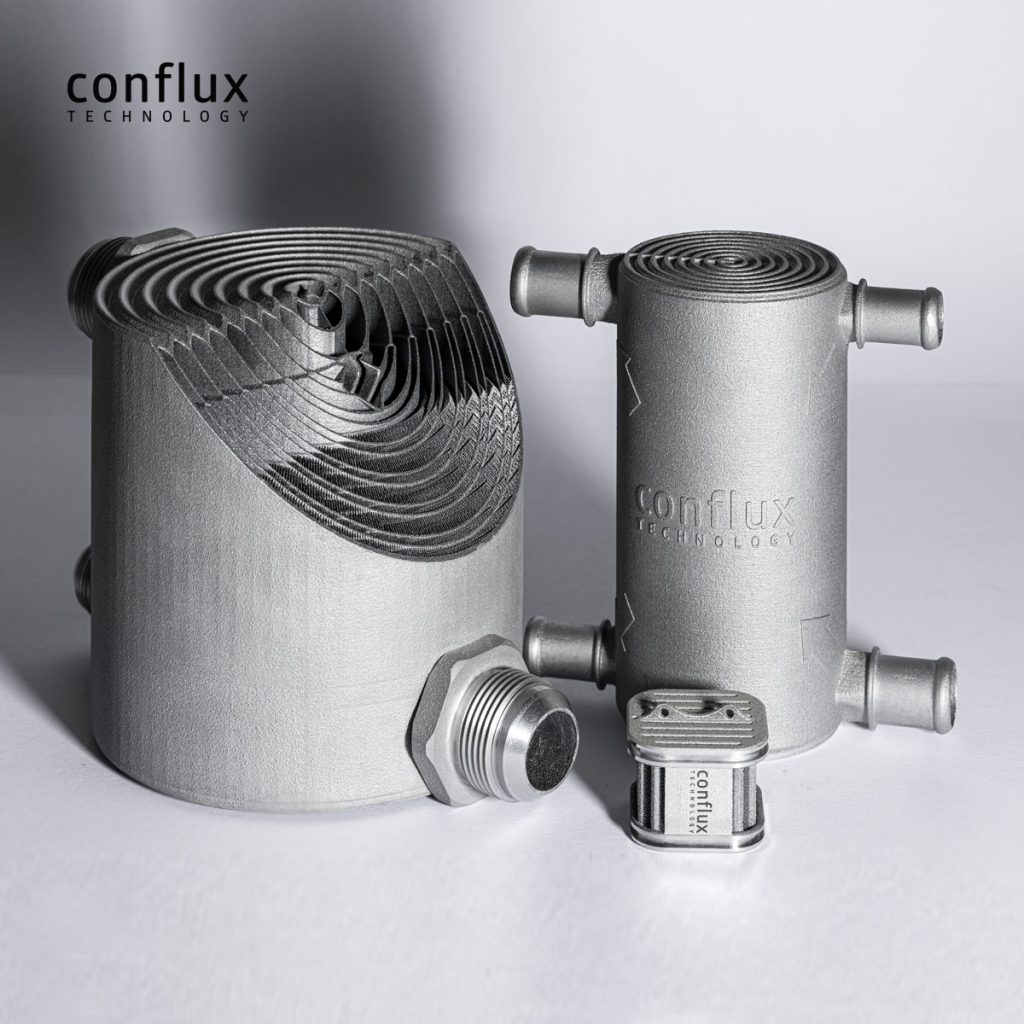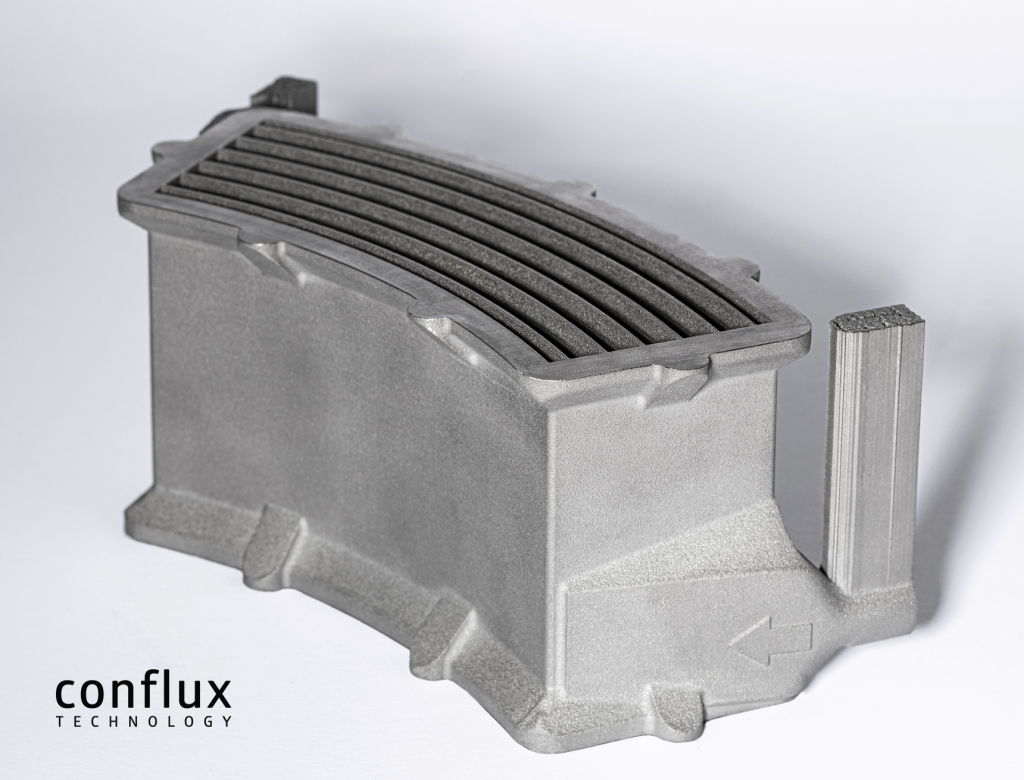Conflux Technology, an Australian heat transfer specialist has teamed with Rocket Factory Augsburg, a German-based space rocket maker. This partnership will allow Conflux’s 3D printed Conflux heat switch technology to be embedded into an orbital launch vehicle.
The heat exchanger components are produced using Conflux Technology’s Monel K 500 metal alloy material, and printed using EOS M300-4 Direct Metal Laser Sintering (DMLS) technology. The gas duct heat exchanger will be manufactured, tested and released for use later in the year.
Part of the Australian Space Agency’s Moon to Mars Initiative, this project is funded by the Supply Chain Capability Improvement Grant Program which awarded Conflux $1 million AUD last year. This initiative and grant aids Australian run projects that could contribute to NASA’s ongoing mission to conduct human spaceflight to the Moon, and eventually Mars. Equally, the initiative also supports the Australian Space Agency’s long-term goal to grow the aerospace industry in the country.
“At conflux we are establishing ourselves as leaders in the development and commercialization of 3D printed thermal solutions and relevant materials for extreme applications,” commented Conflux Chief Commercial Officer Dan Woodford. “With support from the Australian Space Agency’s Moon to Mars Grant Supply Chain Capability Improvement grant, we are now applying it to the rapidly expanding space industry.”
When the funding was announced, Conflux CEO and Founder Michael Fuller said that “We are extremely excited to put our HXs into space! This grant will facilitate the technical development and commercial deployment of our heat exchangers in the most extreme environments…rocket engines.”

Conflux Monel M 500 technology and EOS M 300 technology
Conflux’s Monel K material, a nickel-copper alloy, is known for its high corrosion resistance, strength and durability, and sees extensive use in marine and chemical processing applications. Monel K is also resistant to pitting corrosion (a form of localized corrosion where small holes are randomly created in metal), and stress corrosion cracking.
The K 500 variant is strengthened by age-hardening or precipitation hardening. This gives it increased strength and hardness. Monel K 500 has high yield strength, tensile and corrosion resistance making it ideal to be used in high-stress aerospace applications as well as the production of heat exchanging parts.
Conflux will use their EOS M300 Direct Metal Laser Sintering machines (DMLS), to manufacture the heat exchanger parts with Monel K500. The M300 has a 50% higher build volume than its predecessor. Additionally, it offers high reliability thanks to the M300’s improved layout, software, and functionality.
Additionally, the M300 includes 4x lasers, which can be used simultaneously in any part of the powder-bed. Each laser does not have to work in a specific quadrant. This reduces build time and allows for higher production throughput. The EOS technology offers a gas flow-optimized chamber that can be calibrated with the EOSYSTEM SmartCal tool. This ensures high quality and repeatability. So much so, Conflux claims that this technology has enabled a “significant step forward in production.”

Additive manufacturing and aerospace uses
3D printing technology in aerospace, particularly for the production of spacecraft, is nothing new. Last month’s launch of Relativity Space’s world’s first 3D printed rocket, Terran 1, marked a significant step forward for additive manufacturing’s role within the space industry.
The rocket, which contained 85% of its parts 3D printed, was launched from Cape Canaveral Space Force Station, Florida. However, it failed to reach orbit and crashed into the Atlantic Ocean. Terran 1 was able to achieve a number milestones during its maiden flight. This rocket became the first 3D printed rocket that successfully launched and passed crucial stages such as Max Q, main engine cut off (MECO), second stage separation, and Max-Q. Relativity Space’s next rocket, Terran R is being developed and will launch next year. For future missions, the company plans to increase its 3D printed rocket makeup to 95%.
Vast, a California-based company that develops space habitation technologies, announced last month that it had acquired Launcher, an American aerospace firm, which is the developer of the 3D-printed E-2 liquid rocket engine. Through this deal, Vast hopes to leverage Launcher’s 3D printed rocket technology to progress their goal of creating artificial gravity space stations. The firm is already looking to utilize Launcher’s Orbiter space tug and hosted payload platform this year, with a view to reaching orbit and testing its on-orbit space station components and subsystems.
Subscribe to the 3D Printing Industry Newsletter Keep up-to-date with 3D printing news. You can also follow our blog TwitterOur website is a good example of this. Facebook Page, and Subscribe to the 3D Printing Industry YouTube Channel to get more exclusive content
Are you interested working in the additive-manufacturing industry? Visit 3D printing jobs To view available positions and jumpstart your career, click here
Featured image: Rocket Factory Augsburg rocket engine. Photo via Conflux Technology.